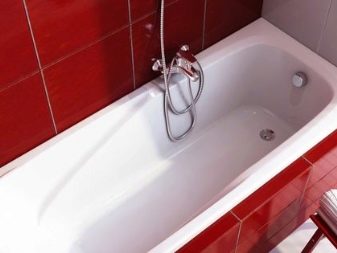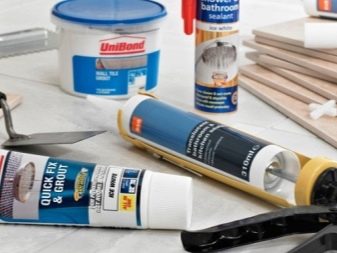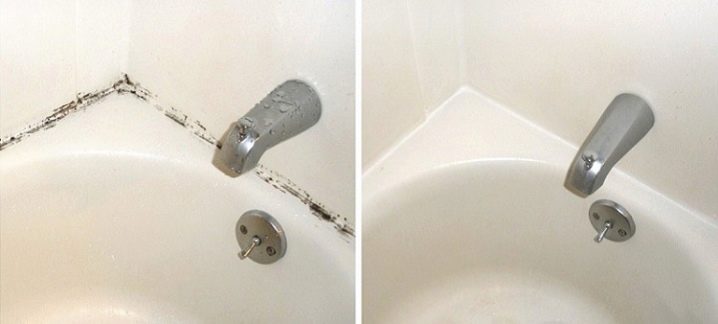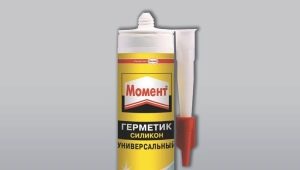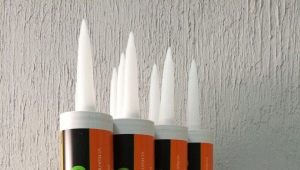Bathroom sealants: which one is better to choose?

High humidity in the bathroom is inevitable. It leads to the gradual destruction of the unprotected parts of the decoration and furniture, creates favorable conditions for the occurrence of mold and mildew. At the same time, the joints of those surfaces where water often falls are particularly affected.
Previously, to prevent the destructive effect of moisture, grouting was used, and now the problem is solved with the help of sanitary sealants.
Special features
These compounds completely fill gaps and cracks, prevent the occurrence of mold, are resistant to temperature fluctuations and the action of water. Masters use them to strengthen the fixture of plumbing to the wall or floor. In addition, sealants are used in outdoor applications.
The composition of sealants include: polymer base (silicone, acrylic, polyurethane), adhesion enhancers, plasticizers, dyes. Some have antiseptic additives. There are products with organic solvents and mineral oils. The main substance determines the characteristics of the sealant, the area of its use, advantages and disadvantages.
Sealing agents differ not only in composition, but also in packaging.
- Tubes in which from 60 to 100 grams of sealant. Sold together with a cone-shaped nozzle. The advantage of packaging is a small amount: you do not need to overpay for a larger amount of sealant when you need to seal one gap. But it is inconvenient to work with tubes, as it is difficult to control the force of pressing.
- Tubes of 300–600 milliliters for a building pistol. The most convenient form of packaging for domestic needs. Using a gun allows you to distribute the composition evenly.
- Aluminum tubes, buckets and barrels. Suitable only for professionals. Such volumes will be redundant, even for owners of private homes.
More often you can see white or transparent means. In fact, their color range is wider - up to 20 colors. If desired, you can find sealants in black, gray, brown, blue, green colors.
Kinds
A detailed review of the types of sealing compositions will begin with the most popular - based on silicone. They are acidic (acetic) and neutral. Acid is cheaper, but has a serious drawback - a sharp smell. During work with them it is necessary to constantly air the room. Another important point: the scope of their application is limited to materials that do not oxidize (ceramics, glass, plastic, stainless steel). And metals during contact with acetic sealants spoil.
Acid sealants also include aquarium sealants - this is a specific group, they are used only for working with glass.
Some examples of acid sealants:
- Ceresit 25 - reliably protects against microorganisms, is well distributed over even and porous surfaces, fastens tile, glass, enamel;
- Bison silicone universal - refers to waterproof, can withstand even the effect of sea water, dries in 15 minutes;
- Ottoseal s100 - the type of seam remains unchanged for 4–5 years, 16 colors to choose from;
- Tytan silicone sanitary - its composition has been improved by bactericidal substances;
In neutral sealants there are no acids. Getting to the surface, they do not enter into a chemical reaction with the material. This makes the work more pleasant, but the price of these compositions is higher.
Some of them:
- Somafix construction - a rare composition of white color that does not turn yellow;
- Ravak Professional - with anti-fungal additives;
- Lugato Wie Gummi is also bactericidal, with a palette of sixteen colors.
Silicone compounds are good because they:
- durable, do not change color over time;
- withstand high humidity and sudden changes in temperature;
- create a reliable grip with different surfaces, including metal, plastic, glass, ceramics;
- are elastic, and therefore they can be used when processing moving joints: the joint of a wall with a bathtub or a shower cabin, drainpipes;
- dry out within 30 minutes, finally harden in 36–48 hours.
But the compositions of this group may suffer from fungus. To protect the seams in very wet areas, it is better to use sanitary or aquarium compounds with antiseptic additives. Sanitary sealant is the most suitable means to protect the seams, which often get water.
Acrylic sealing compounds are less suitable for working in the bathroom. Drying out, they shrink strongly, so the seam, often in contact with water, leaks. The connection is hard and unreliable: it collapses already when stretched to 10%.
Acrylic and steel baths (or shower trays) change their size slightly when heated, causing the connection to the wall to become mobile. The layer of acrylic sealant will soon crack.
But to fill cracks, cracks and other fixed joints to use such compositions conveniently. They can also process the edges of the furniture and the gap between the sink and the wall.
Advantages of acrylic sealants:
- chemically neutral composition, does not react with surfaces, is not hazardous to health;
- have good adhesion to plastic, glass, metal, concrete, brick and other building materials;
- dries in 15–20 minutes, hardens in a day;
- from above you can apply putty, paint, varnish;
- maintains temperature from-20 to +80 degrees.
Another nice thing is that acrylics are cheaper than others. But the composition for the bathroom must be moisture resistant, even if it is not constantly leaking water: the tool may suffer from condensate or accidental splashes.
Here are examples of acrylic formulations:
- KIM TEC Silacryl 121 - moisture resistant sealant, withstands prolonged exposure to water;
- Dap Alex Plus - highly elastic siliconized acrylic composition with fungicides;
- "Moment Germent", Penosil - for sealing gaps and seams, non-interacting with water.
However, manufacturers have found a way to "bring to mind" the compositions of acrylic: made them siliconized. Silicone-acrylic sealants are more resilient and last longer than acrylics and are just as harmless. In addition, they can glue different surfaces.
Another group of funds - polyurethane. For adhesive strength, they are called adhesive-sealants.
In addition, they differ:
- elasticity;
- no shrinkage during drying;
- resistant to low temperatures, ultraviolet, humidity.
But working with these compounds in the bathroom is difficult: prevent their poor adhesion to plastics. They will qualitatively close the joint between the wall and the metal bath or the faience washbasin, but in order to install the acrylic bath, you will have to look for another means.
There are other limitations:
- the moisture level of the treated surface should not exceed 10%, otherwise a preliminary primer will be required;
- The maximum allowable temperature in the zone of use is +120 degrees.
Compounds with polyurethane is preferable to acrylic. And choosing between compositions with polyurethane or silicone, it is desirable to focus on the surface material and the location of the seams.
Polyurethane sealants do not smell, but they are dangerous for the skin, so before work it is advisable to stock up on protective equipment: gloves, a mask.
A few examples:
- Polyurethane 50 FC - dries in 10 minutes, creates a good adhesion with plastic;
- Bostik PU 2638 - adhesive sealant, available in white, gray, brown and black;
- Tytan rubber is well suited for repairing seams made by silicone compounds.
A new type of product - with MS polymers - combines the properties of silicone and polyurethane sealants. These agents form strong but elastic joints. Stitches can withstand stretching up to 25%. They have good adhesion to all construction materials, including plastic. They do not spread, they lie equally well on both horizontal and vertical surfaces. Thanks to this, it is convenient to handle shower cabins.
Here are the remaining properties:
- almost odorless, no solvents in the composition;
- dry at room temperature for 10–30 minutes;
- do not deteriorate under the action of ultraviolet radiation, over time do not fade;
- maintain long contact with fresh and salty water;
- block the development of mold and mildew;
- finished seams can be painted.
Many large manufacturers have products with MS polymers. Among them:
- 1000 usos - has anti-mold properties, presented in 10 colors;
- Bisin MS Polymer - glues any materials: from glass to brick, from rubber to iron;
- Soudaseal 240 FX - suitable for bathrooms, bathrooms and kitchens, cures in 10 minutes;
- Bostic Soperfix - waterproof, indispensable for work under water, in rooms with very humid air (even in pools);
- Tecfix MS 441 - protects against chlorine and sea water, there are additives against microorganisms.
The compositions may differ due to additives, which give these or other properties. The price of such sealants is higher, but the quality of the connections fully justifies it.
The only drawback of these compounds is that they cannot be removed with a solvent.
Scope of application
People are often interested in which parts of the bathroom need to be treated with sealants and how to choose the right tool in each case. In this we now understand.
First of all, you need to protect from the water gap:
- near the bath or shower, where they are bordered by the floor and walls;
- wall and back of the sink;
- between the floor and the toilet.
Universal remedy for this is silicone sealant. You can use compounds with polyurethane or MS-polymers.But acrylic is better not to use: the seams will quickly become worthless.
Adhesive sealants will replace conventional glue.
This property can be used:
- at assembly of the sewerage - they increase durability of connections;
- for processing the shower cabin - they fill the gap between the door and the pan, so that during washing the water does not run down to the floor;
- when finishing the walls with tiles - if you want to glue the tile to metal, plastic, plywood, drywall, chipboard;
- for repairing cracks in tiles and crevices along door jambs, fixing ceiling plinth - an acrylic composition will cope better with this task.
Also, the sealant can be used as a grout: fill them with seams between the tiles. Connection will be more elastic and durable. If you want to revive the interior a little, buy colored sealant. You can choose a color that is contrasting to the tile or similar in color but different in shade.
Sealants are also useful in the kitchen. They handle all sorts of joints around the sink, protect the pipe connections, use instead of glue. More sealants are needed when you need to change plumbing equipment.
Criterias of choice
Masters say that a properly chosen sealant greatly increases the chance of getting durable and beautiful seams. This is especially true of the bathroom.Constant fluctuations in temperature, humid air, high risk of mold occurrence - not every compound will withstand these tests.
When buying a sealing compound, pay attention to several parameters: this will increase the chances of not wasting money.
- In rooms with high humidity it is recommended to use only moisture-resistant compositions, and preferably with a fungicide that stops the growth of the fungus.
- It is more convenient to work with a tool that has a thick pasty consistency, especially on vertical surfaces.
- Most of the white sealants turn yellow, but this does not happen with a transparent one.
- In a good tool, the volume of additional components does not exceed 10%. Then they will not affect the insulation qualities.
- It is better to choose not the cheapest, but high-quality sealant of a proven manufacturer (Ceresit, Belinka, CIKI Fix, TYTAN, “Moment”).
- If there is a choice between a professional and reliable household composition, it is better to stop at the second: it is easier to work with him in everyday life.
How to apply?
The sealing process can be divided into three parts: the preparation of tools and surfaces, the application of sealant and finishing.Do not skip the first and last part of the process - the results of the hastily carried out work will have to be redone many times.
Remove everything from the surface that may impair adhesion and provoke fungus and mold: contamination, remnants of the former sealant. Some masters advise degreasing it with alcohol or nail polish remover. After that, all you need to wipe, and deep sutures to dry with a hairdryer. Traces of acrylic and silicone compounds are easy to clean with solvents (Penta-840, Silicone Remover, and others). The remains of polyurethane sealant can be torn off with a metal brush.
The surfaces along the seam can be stuck with masking tape: this will help to make the sealant strip even and neat, and leave the adjacent surfaces clean.
Cut off the tip of the package at a 45 degree angle. The location of the cut depends on the width of the seam. After that, insert the sealant into the gun.
It's time to start the main part of the work.
- Pistol gently squeeze the tool, gradually moving the bottle over the entire length of the seam. It is important to ensure that the sealant is deep and evenly distributed.
- Place the object to be processed around the perimeter.The lines should be smooth, without breaks, in which drops of water will accumulate.
- Remove the tape until the composition has hardened to the end. If suddenly the seam has suffered at the same time - moisten it with water and level it. It is easy to scrub fresh traces of sealant from tiles and plumbing with a wet cloth. Solvent will help to cope with old pollution.
When finished, be sure to ventilate the room and wait until the seams are completely dry.
Tips
Experts advise when working with sealing compounds in the bathroom to adhere to some important recommendations.
- It is more convenient to cover up a deep seam with a sealant if you put a foam plastic strip: this will stop the flow of the product.
- When processing a protective corner near the bath, first squeeze the sealant on the wall and the shelf of the bath, then put the part itself and press it.
- When gluing tile, do not squeeze out too much sealant - enough thin strips along the edges and diagonals of the tile. Then press it firmly to the surface.
- Using a sealant instead of grouting the joints between tiles, it is convenient to use masking tape: protect the surfaces near the joint with them. Remove surplus quickly with a spatula.Fill the seams to the full depth.
- And so that in the bathroom, in the kitchen and in the toilet the mold never appears, it is advisable to arrange there additional heating and ventilation. After all, any sealant will last longer if you do not expose it to unnecessary tests.
To learn how to work with silicone sealant, see the next video.
